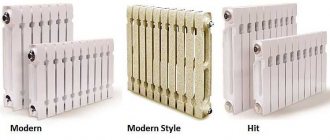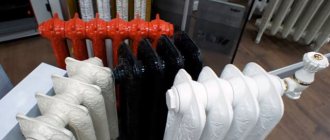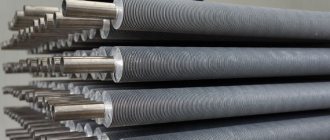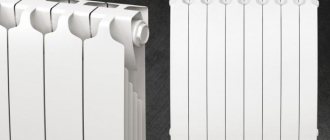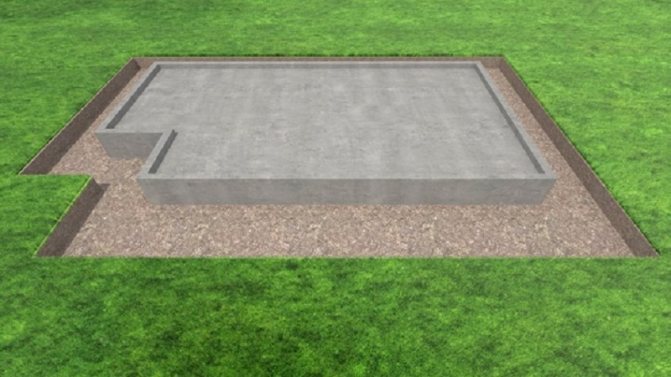
Cast iron radiators are considered classics of water heating: since invention in 1857 to the present day, they are used in many houses and apartments.
Corrosion resistance, high heat transfer, low hydraulic resistance, thermal inertness - qualities that ensure the demand for these products.
Cast iron radiators have sectional structure. Equipped with locking devices, plugs, plugs, nipples, gaskets.
The products are heavy, they are mounted on special wall brackets, but there are also floor standing batteries with legs. Heaters provide comfort mode: up to 35% heat transmitted by radiation, the rest - by convection.
Odnoklassniki
Features of the repair of a cast iron battery
By its structure, cast iron differs from ordinary metal in fragility. The main feature of its repair is careful handling of the radiator. If a leak occurs, the damaged area should not be tapped against rust and scale. The blows inflicted will lead to the appearance of new microcracks, which will begin to expand when the hot coolant enters.
This also applies to cast iron radiators, which are flushed. Do not hit the sections with a metal hammer so that the dirt falls off faster. If disassembly into sections is foreseen, then the connecting nipples are unscrewed carefully. They are also cast iron and can crack.
Advice! In an old radiator, it is difficult to unscrew the connecting cast-iron nipples, since the threads are very sour. To simplify the situation, warming up with a blowtorch helps. Despite its massive weight, the cast-iron radiator is fragile and shock-resistant
If the leak can be repaired using a bandage method, then the area near the crack is simply cleaned out. Such actions will not destroy the cast iron walls of the section. Tapping is sometimes required during flushing. This can be done, but lightly and only with a wooden hammer.
Cast iron Soviet radiators after a long service life do not look aesthetically pleasing. For this reason, they often try to get rid of them. However, they can be turned into completely new batteries by taking advantage of another repair feature. It consists of four steps:
- The cast-iron old radiator is washed with chemical reagents. The action helps to clean the inside of the section from dirt, rust, solid salt deposits.
- The washed radiator is disassembled into sections. The section of the collector where you need to unscrew the cast-iron nipple is heated with a blowtorch.
- Each cast iron section is sandblasted from above. As a result, it cannot be distinguished from a new product.
- After cleaning, the cast iron sections are reassembled into a battery. New sealing rings are installed in the areas where the collectors are joined. If the nipples are bad, they are changed in the same way. It is optimal to replace the side plugs where the pipeline is connected to the radiator. Their threads will already be worn out, and a leak may appear in this place.
After the repair, a new radiator appears at the exit. It is these cast-iron batteries that are most often sold by firms after restoration, passing them off as a new product. Now it remains to paint and hang the radiator in its place.
Video: how to paint a radiator
Describe your question in as much detail as possible and our expert will answer it
I had central heating in my apartment. In winter, the batteries warmed terribly, they were constantly cold. I decided to install autonomous heating. I managed with a budget option. I bought only a boiler, a double-circuit Bosch, and a few meters of steel pipes.I left the batteries old, cast iron. Naturally, before installing the entire old system, I disassembled and cleaned the old batteries. I removed the paint with a construction hairdryer. I did not disassemble the sections, they were normally connected. I washed the batteries inside and cleaned them with steel wire. Installed in place, connected to pipes and installed Mayevsky taps in order to bleed the batteries if necessary and drain excess water at high pressure. Cast iron batteries keep heat longer than metal or aluminum ones. The aesthetic look was also tidied up. Painted with water-based acrylic paint for radiators. The paint has no smell. It is water based and dries quickly. In hard-to-reach places I used a bent brush, such as a spoon. Over time, you can repaint with a new thin layer, since any paint turns yellow after heating the batteries. For a more attractive aesthetic look, I placed decorative grilles on top. Looks ok, warm and budget.
As is known from time immemorial: cast iron refers to materials that can maintain a given temperature for a long time. That is why our fathers and grandfathers made bathtubs and radiators for heating from cast iron.
Today, in any hardware store, a wide variety of radiators are widely represented, but, unfortunately, you will not find cast-iron ones with fire in the daytime. Modern radiators have one significant advantage: they do not undergo a corrosive process (in other words, do not rust) because of how much the main material for their manufacture is aluminum. But at the same time, an important drawback is inherent: they instantly give off all the heat received from the passing water. Therefore, at the slightest drop in temperature in the system, you will immediately feel it on yourself.
Why a cast iron battery can break
There are few reasons for the appearance of a defect on the cast-iron sections of the radiator, but they are. Malfunctions may even appear without leaking, which will result in poor battery performance. To find the right way to repair, you need to correctly determine the cause of the breakdown:
- Cast iron heating appliances are heavy. If they are suspended on weak brackets, they become skewed over time. The sections begin to "air" and do not heat. From weak brackets, the radiator is capable of breaking loose, breaking the pipeline. If dropped from the impact, cracks will appear on the cast iron sections. The wall of the section is capable of cracking from a water hammer
- Cast iron is weakly resistant to water hammer in the heating system, other mechanical influences caused by a person during installation. Even if the section is not cracked, a leak can appear at the joints.
- Clogging is a common cause of malfunction. Dirt and salt deposits settle inside the sections. Periodically, it is required to carry out major repairs with flushing with chemical reagents. The rubber rings on the connection of the section headers need to be changed periodically.
- At the junctions of the section collectors, rubber rings are installed. The gaskets wear out over time. The rubber is corroded by chemicals during flushing. During a major overhaul, the gaskets must be changed.
- The cause of a breakdown can be a banal defrosting of the radiator. For example, the owner does not appear at the dacha for a long time. In severe frosts, the coolant freezes in the heating system. From the expansion of water, the cast-iron section breaks.
It is not difficult to identify signs of breakdown. Cold areas indicate contamination or airborne radiator. If there is no leak on the cast-iron surface yet, but a white or rusty coating has already appeared, this is the first "call" about the danger. It is impossible to delay the repair.
Advice! If the radiator shows several signs of malfunction at the same time, it is better to replace it. The dismantled battery is sent for overhaul.
How to achieve the aesthetic appearance of old batteries
With the inside of the batteries cleaned and any worn gaskets replaced, the feature upgrade is complete. It's time to take care of the exterior so that the heating devices fit well into the interior. To do this, it is enough to paint them. If desired, the batteries are decorated with original painting, decoupage images, or simply covered with special screens. But you will have to paint in any case. It is important to choose the right paint composition and follow the application technology.
The subtleties of choosing radiator paints
Increased demands are placed on radiator paints. They must be resistant to high temperatures, wear-resistant, safe. It is also important that the coating does not compromise thermal conductivity. Manufacturers offer the following formulations:
Methods for repairing cast iron heating batteries
The repair technology depends on the cause of the malfunction. If there is frequent airing due to skewing, the radiator is aligned horizontally on the wall, reinforced with additional brackets. When the sections are clogged, there is only one repair method - flushing with reagents.
When a leak appears, folk repair methods are often used:
- A small crack in the section is repaired by gluing it with epoxy resin with pieces of gauze. This method will help eliminate leaks on the pipe leading to the radiator or at the junction of the section headers. To eliminate the leak in an accessible area, a bandage impregnated with epoxy resin is wound
- The radiator manifold or supply pipe has a circular cross-section. To eliminate the leak will help the imposition of a clamp.
- Cold welding will help to seal the crack on the radiator. An emergency repair tool resembles plasticine, which must be kneaded with your hands and glued to a clean surface. Cold welding will help to quickly eliminate leaks
Each repair method is selected individually for a specific situation. It all depends on where the leak was formed.
How to repair a cast iron radiator
Repair begins with preparatory steps. A film is covered under the radiator, since water and dirt are indispensable here. It is important to know if the chosen method of gluing with epoxy resin or cold welding, then the radiator must be disconnected from the heating system, otherwise the coolant flow will not allow the bandage to stick to the cast-iron surface. However, this can be done when the battery is equipped with shut-off valves.
Suppose there are taps on the piping to the radiator. They must be closed before starting repairs. The next step is to drain the coolant from the battery to eliminate the leak. The problem area is cleaned of paint, dirt, rust. Degrease with acetone or alcohol. Epoxy is applied to a strip of bandage or cotton fabric. If the crack is on a flat section, then the patch is simply glued in several layers, giving time for each of them to harden. On the section of the supply pipe or the collector, the tarred bandage is wound in the form of a bandage. After hardening, the area is painted over to match the color of the radiator.
The problem area is cleaned of paint and degreased before repair
Similar actions are performed when the repair of a cast-iron battery by cold welding is provided, but a bandage or a strip of cloth will be needed for other actions. The tool resembles plasticine. Before use, cut off the required amount of mass and knead it with your hands. During this time, the mixing of the components responsible for the curing of the cold welding takes place. The softened mass is glued to the area requiring repair. Try to wind a bandage on top with a strip of fabric. The harder the cold weld is pressed against the cast iron surface, the stronger the patch will be.
Advice! Instead of cloth, tape or strips of other material can be used to press down on the cold weld.
The clamp will help to eliminate the leak if it is impossible to disconnect the radiator from the heating system
In apartments with an old renovation, cast-iron radiators are installed without shut-off valves. Repair with epoxy resin or cold welding is not possible, as the coolant constantly leaks. If the problem area is on the pipe or the connection of the section manifolds, the clamp will help out. The product for the bandage consists of one split ring or two half rings. Bolts are provided for the screed. The rubber strip acts as a seal. The clamp is installed on the problem area, the bolts are tightened until the leak stops.
Overhaul requires complete disassembly of the radiator
If there is more than one leak, it is better to disassemble such a radiator immediately. Before that, it is disconnected from the heating system, the coolant is drained. Repairs are carried out in the following sequence:
- When a cast-iron battery is connected to the heating system with metal pipes that have served for more than a dozen years, it makes no sense to unwind the squeegees. They will end anyway. The threads are cut with a grinder. In their place, new squeegees will have to be welded.
- The radiator is removed from the brackets and placed on the floor. Using a wrench, they try to unscrew the plugs from the manifolds and the nuts with cut-off beads. It is important to remember that one manifold will have a right hand thread and the other a left hand thread. If the nuts do not go, they are heated with a blowtorch. After unscrewing on the plugs, the threads are cleaned with a metal brush. It is better to throw out nuts with cut off grips and buy new ones. It is difficult to unscrew the threaded tube pieces.
- To disconnect the sections, a special key is introduced into the collector. One end of it resembles a shoulder blade. It is with this flat part that they are looking for a hook on the antennae of a cast-iron nipple. It similarly has a right-hand and left-hand thread. They try to rip off the nipple with a key and turn it a couple of turns. If it does not give in, the collector section is heated with a blowtorch. A similar operation is performed on the opposite manifold. Each nipple is alternately turned a couple of turns until the section is completely disconnected.
Likewise, you can disassemble the entire radiator or separate damaged sections. If there is a lot of dirt inside, caustic soda is used for rinsing. A solution of 9% vinegar and water in a 1: 1 ratio is suitable. In extreme cases, a 5% sulfuric acid solution is used. For flushing, the liquid is poured into the radiator for a day, then washed with clean water. After these actions, the battery is disconnected into separate sections, the O-rings are changed, and the reassembly is performed.
In the video, you can learn more about the repair of heating radiators:
Repair of cast iron radiators
It is not so easy to repair cast-iron heating batteries with your own hands. This is due not only to the impressive weight of the device, but also to the fact that this type of battery was installed back in Soviet times. It is very difficult to unscrew the plugs from such devices. For this, the junction is well heated, because in the last century, a rope moistened with paint was used as a seal. Only heating can soften the hardened seal.
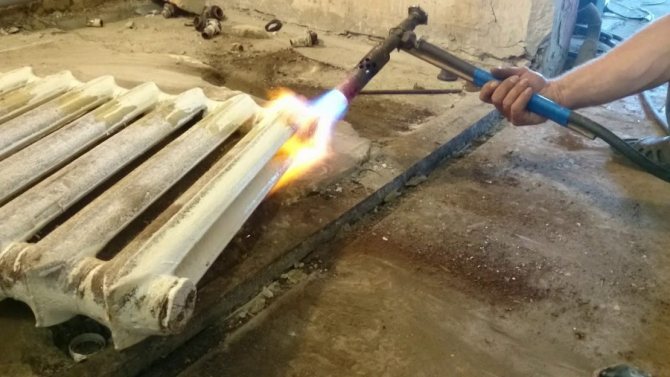

If the cast-iron battery bursts, we will tell you how to repair it further.
Minor cracks and fistulas in cast iron units are repaired in one of the following ways:
- To close the fistula, a special clamp is used. Instead, the damage can be wrapped several times with rubber tape.
- Small holes are sealed with cold welding. For this, the crushed material is applied to the damaged area.
- If you soak the bandage with epoxy glue and wrap the damaged area, you can fix the leak. It will stop after the glue has set.
- Minor defects can be repaired with a moisture resistant sealant.
All the methods given above are temporary measures to prevent leakage before the arrival of the master. Only specialists can completely replace the radiator or weld the hole securely.
Advice! To prolong the life of a cast iron battery, it must be painted regularly. It is advisable to do this after turning off the heating. Remove the old paint layer and degrease the surface.
Professional advice
A few tips to help you make an effective renovation:
- After repair, the radiator will have to be painted. If it is hidden behind a decorative screen, it is advisable to choose a dark paint. A cast iron battery will better give off heat.
- The hanging brackets are positioned so that the gap between the radiator and the window sill is 10 cm, and the floor is 12-15 cm.
- To reflect heat, the wall behind the cast-iron battery is sealed with foil material.
Heating efficiency depends on the number of sections on each radiator. Here you need competent calculations, which will be helped by experienced specialists.
